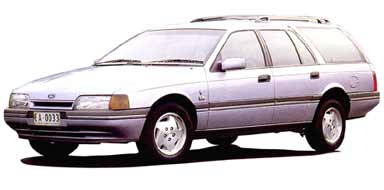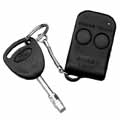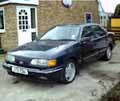
| Ford EA Falcon | |||||||
| On Sale: March 1988 - July 1991 (Series II: October 1989) | |||||||
| How
do I know it's an EA? Rounded headlights with amber indicators, horizontal
thin grille with Ford badge above it, tail lights have horizontal bar
separating brake light and indicator. Rear number plate mounted on grey
or black & grey plastic, B-pillars are black, C-pillars have air vent,
Fairmont Ghia has body-coloured mirrors, GL has black bumpers. Series II: Body-coloured B-pillars. 30th Anniversary models: Falcon bird badge near front wheels, GL has “swirl” wheel covers and bigger side mouldings. Fairmont has alloy wheels. |
|||||||
|
|||||||
|
|||||||
| What’s new? New fuel injected engines, redesigned front suspension, two millionth Falcon | |||||||
| Falcon Firsts: First Australian car with 60/40 split fold rear seat, four speed auto (Series II) | |||||||
| Prices at introduction: Falcon GL sedan - $19431, Fairmont Ghia sedan - $30354 | |||||||
| Total EAs built: 223612 | |||||||
| Transmission: 5 speed manual, 3 speed automatic, 4 speed automatic (Series II) | |||||||
| Engines: 3.2L 6 cyl Bore and stroke: 92 x 79 mm Power: 90kW at 4000rpm Torque: 235Nm at 3250rpm Overhead camshaft, 2 valves per cylinder Fuel system: EEC IV fuel injection Compression ratio: 8.8:1 |
3.9L 6 cyl Bore and stroke: 92 x 99 mm Power: 120kW at 4250rpm Torque: 311Nm at 3250rpm Overhead camshaft, 2 valves per cylinder Fuel system: EEC IV fuel injection Compression ratio: 8.8:1 |
||||||
| 3.9L
multi-point 6 cyl Bore and stroke: 93 x 99 mm Power: 139kW at 4250rpm Torque: 338Nm at 3500rpm Overhead camshaft, 2 valves per cylinder Fuel system: EEC IV fuel injection Compression ratio: 8.8:1 |
|||||||
| Fuel consumption: 14.1L/100km (Falcon S 3.9 auto, Wheels magazine) | |||||||
| Performance: (Falcon S 3.9L multi-point sedan, 5 speed manual): Top speeds in gears 1st: 57km/h 2nd: 93km/h 3rd: 144km/h 4th: 200km/h 5th: 210km/h 0-100km/h: 8.5 seconds Standing 400m: 15.8 seconds |
|||||||
| Suspension: Front Short and long arm, long spindle with single rate coil springs, twin tube telescopic shock absorbers and stabiliser bar |
Rear Sedan - Live axle with Watts linkage telescopic shock absorbers, coil springs and stabiliser bar; Wagon - Rigid axle with leaf springs and telescopic shock absorbers; S sedan - Uprated coil springs and shock absorbers with lower ride height |
||||||
| Brakes: Front 287mm ventilated discs |
Rear 287mm discs |
||||||
| Steering: Power assisted rack and pinion | |||||||
| Wheels:
Falcon GL, Fairmont - 14 x 6 inch JJ steel, optional - 15 x 7 inch JJ alloy, October 1990 - 14 x 6 inch JJ alloy on Fairmont Falcon S - 15 x 7 inch JJ alloy snowflake Fairmont Ghia - 15 x 6.5 inch JJ alloy |
|||||||
| Tyres:
Falcon GL - P185/75 HR14, optional - P215/65 HR14 Falcon S - P205/65 HR15 Fairmont - P195 HR14, optional - P215/65 HR14, P205/65 HR15 Fairmont Ghia - P205/65 HR15 |
|||||||
Dimensions:
|
Interior
dimensions:
|
||||||
Features
(at introduction): Legend
|
|||||||
| Awards: 1988 Australian Design Award | |||||||
| Rivals: Holden VL/VN Commodore, Mitsubishi TN/TP/TR Magna, Toyota Lexcen | |||||||
| EA Falcon Links (new window) | Related pages | ||||||
| The
EA-ED Owners Club Home Page |
Falcon
Facts: NA Fairlane / DA LTD Falcon Facts: XF Falcon Falcon Facts: EB Falcon |
||||||
|
Where to now? Back to Falcon main On to EB Falcon» |
|||||||



